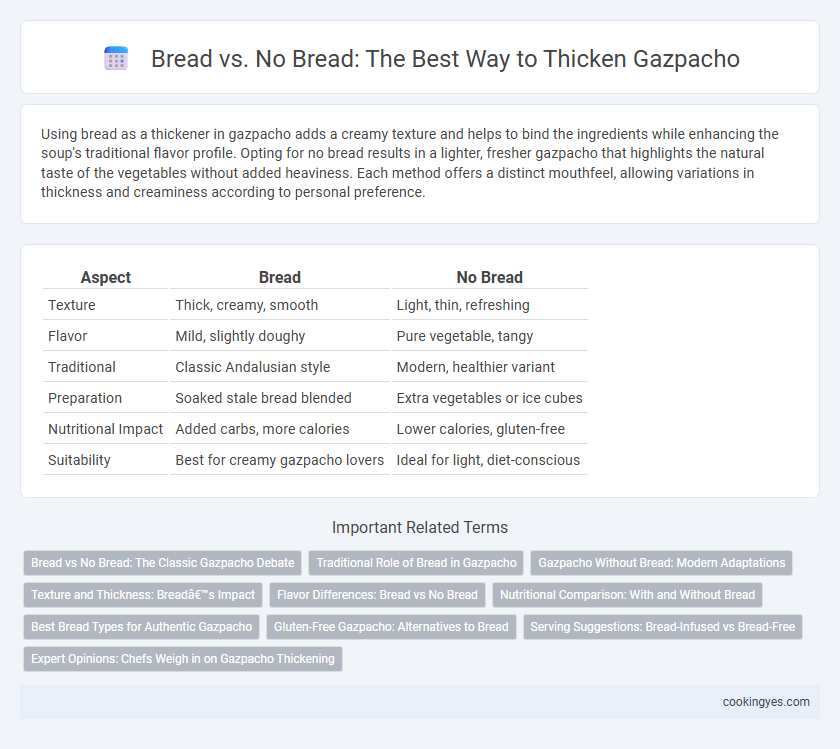Using bread as a thickener in gazpacho adds a creamy texture and helps to bind the ingredients while enhancing the soup's traditional flavor profile. Opting for no bread results in a lighter, fresher gazpacho that highlights the natural taste of the vegetables without added heaviness. Each method offers a distinct mouthfeel, allowing variations in thickness and creaminess according to personal preference.
Table of Comparison
| Aspect | Bread | No Bread |
|---|---|---|
| Texture | Thick, creamy, smooth | Light, thin, refreshing |
| Flavor | Mild, slightly doughy | Pure vegetable, tangy |
| Traditional | Classic Andalusian style | Modern, healthier variant |
| Preparation | Soaked stale bread blended | Extra vegetables or ice cubes |
| Nutritional Impact | Added carbs, more calories | Lower calories, gluten-free |
| Suitability | Best for creamy gazpacho lovers | Ideal for light, diet-conscious |
Bread vs No Bread: The Classic Gazpacho Debate
The classic gazpacho debate hinges on whether to thicken the soup with bread or keep it bread-free, significantly impacting texture and flavor. Bread-thickened gazpacho offers a creamy, velvety consistency that enhances the traditional Andalusian taste, while no-bread versions present a lighter, fresher profile emphasizing pure vegetable intensity. Balancing the choice depends on personal preference and the desired gastronomic experience, with bread providing body and no bread delivering clarity.
Traditional Role of Bread in Gazpacho
Traditional gazpacho recipes rely on stale bread as a key ingredient to achieve a rich, creamy texture and enhance the soup's body. The bread absorbs the tomato juice and vegetable flavors, creating a velvety consistency that distinguishes classic Andalusian gazpacho. Omitting bread results in a lighter, more liquid soup but loses the traditional mouthfeel and thickness characteristic of authentic gazpacho.
Gazpacho Without Bread: Modern Adaptations
Gazpacho without bread offers a lighter, fresher take on the traditional Andalusian recipe by relying on pureed vegetables like cucumber, tomato, and bell pepper for natural thickness. Modern adaptations often incorporate ingredients such as avocado or almonds to enhance creaminess while maintaining a gluten-free profile. This approach appeals to health-conscious consumers seeking a vibrant, low-calorie soup without compromising the classic gazpacho flavors.
Texture and Thickness: Bread’s Impact
In gazpacho, bread significantly enhances texture and thickness by adding creamy body and smoothness, resulting in a richer and more velvety mouthfeel. Without bread, the soup remains lighter and thinner, highlighting the freshness of the vegetables but lacking the dense, satisfying consistency that bread imparts. The starch in bread acts as a natural thickener, creating a balanced viscosity integral to traditional Andalusian gazpacho.
Flavor Differences: Bread vs No Bread
Using bread to thicken gazpacho adds a subtle yeasty richness and creamy texture that balances the acidity of tomatoes, enhancing the soup's overall depth of flavor. Without bread, gazpacho tends to have a lighter, fresher taste profile dominated by bright vegetables and herbs, allowing the natural sweetness and acidity to shine through more distinctly. The choice between bread or no bread ultimately influences the mouthfeel and flavor complexity, catering to different regional preferences and dietary considerations.
Nutritional Comparison: With and Without Bread
Gazpacho thickened with bread contains additional carbohydrates and dietary fiber, contributing to increased energy content and improved digestion compared to its bread-free counterpart. Excluding bread reduces calories and gluten content, making the soup more suitable for low-carb and gluten-sensitive diets while retaining its rich antioxidant profile from fresh vegetables. The choice between bread and no bread influences the soup's macronutrient balance and suitability for specific dietary needs.
Best Bread Types for Authentic Gazpacho
Traditional gazpacho uses day-old rustic bread like Spanish baguette or country-style loaf to achieve a smooth, creamy texture without overpowering the fresh vegetable flavors. Stale white bread with a firm crust absorbs the liquid well, contributing to the desired thickness while maintaining authenticity. Avoid dense, heavily seeded, or sweet breads, as they can alter the classic taste and texture of traditional Andalusian gazpacho.
Gluten-Free Gazpacho: Alternatives to Bread
Gluten-free gazpacho recipes often replace traditional bread with alternatives like soaked almonds, cooked quinoa, or chia seeds to achieve a creamy texture without gluten. These substitutes not only thicken the soup but also add nutritional value, enhancing fiber and protein content. Using vegetables such as cucumber or avocado can also provide natural creaminess while maintaining a light, refreshing flavor profile ideal for gluten-sensitive individuals.
Serving Suggestions: Bread-Infused vs Bread-Free
Gazpacho thickened with bread delivers a creamy texture and richer flavor, enhancing the soup's traditional Andalusian authenticity, often served chilled with garnishes like diced cucumber, bell peppers, and a drizzle of olive oil. Bread-free gazpacho offers a lighter, fresher taste ideal for those seeking gluten-free options or a more vibrant vegetable-forward experience, frequently complemented by fresh herbs, diced tomatoes, and a splash of vinegar. Choosing between bread-infused and bread-free gazpacho depends on dietary preferences and desired consistency, with both versions showcasing the vibrant freshness of ripe tomatoes and seasonal produce.
Expert Opinions: Chefs Weigh in on Gazpacho Thickening
Chefs emphasize that traditional Andalusian gazpacho relies on stale bread to achieve a creamy texture and balanced mouthfeel, enhancing the soup's body without overwhelming freshness. Some experts advocate omitting bread for a lighter, more vibrant flavor profile, catering to gluten-free diets and highlighting the raw vegetable ingredients. Professional opinions converge on personal preference and regional variations, with many recommending blurring the line between chunky and smooth for optimal texture.
Bread vs No Bread for gazpacho thickening Infographic

 cookingyes.com
cookingyes.com